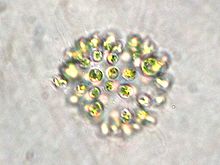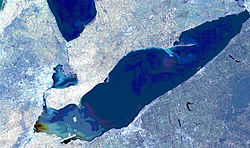- Microcystis aeruginosa
-
Microcystis aeruginosa 
Scientific classification Kingdom: Bacteria Subkingdom: Eubacteria Phylum: Cyanobacteria Class: Cyanophyceae Order: Chroococcales Family: Microcystaceae Genus: Microcystis Species: M. aeruginosa Binomial name Microcystis aeruginosa
Kützing, 1846Microcystis aeruginosa is a species of freshwater cyanobacteria which can form harmful algal blooms (HABs) that are of economic and ecological importance.[1][2] They are the most common toxic cyanobacterial bloom in eutrophic freshwater.[2]
Contents
Characteristics
As the etymological derivation implies, Microcystis is characterized by small cells (of only a few microns' diameter), which lack individual sheaths.[4]
Cells usually are organized into colonies (large colonies of which may be viewed with the naked eye) that begin in a spherical shape, but losing their coherence to become perforated or irregularly shaped over time.
The coloration of the protoplast is a light blue-green, appearing dark or brown due to optical effects of gas-filled vesicles; this can be useful as a distinguishing characteristic when using light microscopy. These vesicles provide the buoyancy necessary for M. aeruginosa to stay at a level within the water column at which they can obtain optimum light and oxygen levels for rapid growth.
Ecology
M. aeruginosa is favored by warm temperatures (Oberholster), but toxicity and maximal growth rates are not totally coupled, as the cyanobacterium has highest laboratory growth rates at 32°C, while toxicity is highest at 20°C, lowering in toxicity as a function of increasing temperatures in excess of 28°C. Growth has been found to be limited below 15°C.
Toxins
M. aeruginosa can produce both neurotoxins (lipopolysaccharides-LPSs)[5] as well as hepatotoxins (microcystins).
Economic importance
Because Microcystis aeruginosa can form persistent microcystin toxins under the right environmental conditions, it has come to be a source of drinking water pollution (which can be rendered hepatotoxic).[6] This can lead to increased economic costs such as water quality mitigation measures in the form of increased costs at water filtration facilities, as well as damage to local tourism caused by lake or other waterway closures due to toxicity concerns.[7]
Ecological importance
In addition, its effect on dissolved oxygen (DO) content in water can lead to fish kill and other marine life death also.[8]
See also
- Cyanobacteria
- Cyanotoxin
- Harmful algal blooms
- Microcystin
References
- ^ "Chroococcales". EOL. http://www.eol.org/pages/3238. Retrieved 24 June 2011.
- ^ a b Oberholster, PJ. "Microcystis aeruginosa: souce of toxic microcystins in drinking water". Microcystis aeruginosa: souce of toxic microcystins in drinking water. African Journal of Biotechnology March 2004 Volume 3 pp 159-168. http://docs.google.com/viewer?a=v&q=cache:VBcNNhpjT88J:https://tspace.library.utoronto.ca/bitstream/1807/3750/1/jb04029.pdf+microcystis+aeruginosa&hl=en&gl=us&pid=bl&srcid=ADGEESgfDSjCPS4BqnJvY1z2c0HFx7ZQ7B6ccBXl0Bq-jrsdk7n6__RyGhk9pWru6lt_Kisp1zNlsOiH_ef4t2osE7p__aFB9F-xwQb5ffbimxhl3wVR96eeSP_2Jqz29rPR62lLmZTp&sig=AHIEtbSZk24-gDPAOyrBgmCLORm_dkSw5w. Retrieved 24 June 2011.
- ^ "Ecosystem Research and Harmful Algal Blooms". Center of Excellence for Great Lakes and Human Health. NOAA. http://www.glerl.noaa.gov/res/Centers/HumanHealth/ecosystem_research.html. Retrieved 27 June 2011.
- ^ "Cyanobacteria: Microcystis". The Silica Secchi Disk. Connecticut College: The SilicaSecchi Disk. http://silicasecchidisk.conncoll.edu/LucidKeys/Carolina_Key/html/Microcystis_Main.html. Retrieved 24 June 2011.
- ^ Mayer, Alejandro M. S.; Jonathan A. Clifford (2). "Cyanobacterial Microcystis aeruginosa Lipopolysaccharide Elicits Release of Superoxide Anion, Thromboxane B2, Cytokines, Chemokines, and Matrix Metalloproteinase-9 by Rat Microglia". Toxicological Sciences 121 (1). http://toxsci.oxfordjournals.org/content/121/1/63.short?rss=1. Retrieved 25 June 2011.
- ^ "Cyanobacterial Toxins: Microcystin-LR in drinking water". Background document for development of WHO Guidelines for Drinking Water Quality. World Health Organization (WHO). http://docs.google.com/viewer?a=v&q=cache:hB3G0xgpX3wJ:www.who.int/water_sanitation_health/dwq/chemicals/cyanobactoxins.pdf+microcystis+aeruginosa+drinking+water&hl=en&gl=us&pid=bl&srcid=ADGEEShcbKCATULdoWmYMmdDDfKwkvn9AGxBiBjfD74GLQKBu2-IxU8u1OVVbVugaxxqc6DQqe50Pmj7xLim9GPFB9i6LHxN5KjoBimSZXBLAIJ3buRhH9nGmCkHiF3O0xOWqsk2qLiY&sig=AHIEtbSVIloCd3Jyb6SYRqRn-8oLPhlUNg. Retrieved 24 June 2011.
- ^ Somek, Hasim. "A Case Report: Algal Bloom of Microcystis aeruginosa in a Drinking-Water Body, Eğirdir Lake, Turkey". A Case Report: Algal Bloom of Microcystis aeruginosa in a Drinking-Water Body, Eğirdir Lake, Turkey. Turkish Journal of Fisheries and Aquatic Sciences. http://www.trjfas.org/pdf/issue_8_1/177_179.pdf. Retrieved 27 June 2011.
- ^ Padmavathi, P; K. Veeraiah (6/04/2009). "Studies on the influence of M. aeruginosa on the ecology and fish production of carp culture ponds". African Journal of Biotechnology 8 (9): 1911–1918. http://docs.google.com/viewer?a=v&q=cache:OwOnahthwzwJ:www.ajol.info/index.php/ajb/article/view/60424/48662+microcystis+aeruginosa+fish+oxygen&hl=en&gl=us&pid=bl&srcid=ADGEESiG-9ZxvSXRfWgCy_Z5pOEpA_yhlInUq2lXrbqP-z-katP-coKMTtkNx8dM5YReydCX3PCnal9vuQ7sBGSY4SI8A-JhSV8O45a4J5CfCqPg5kNg2mH-VFQFloWfuxmEYSSou29z&sig=AHIEtbTBoCow_KNi18hpPYnCUB2bZ-c2gw. Retrieved 24 June 2011.
Categories:- Cyanobacteria
- Species described in 1846
- Bacteria stubs
Wikimedia Foundation. 2010.

